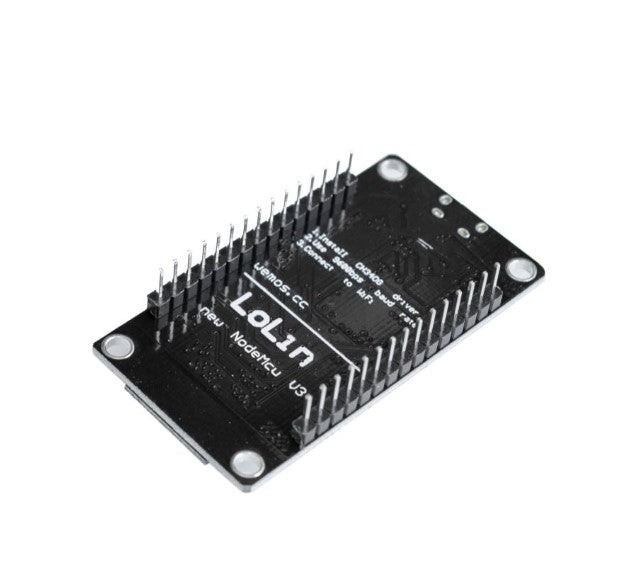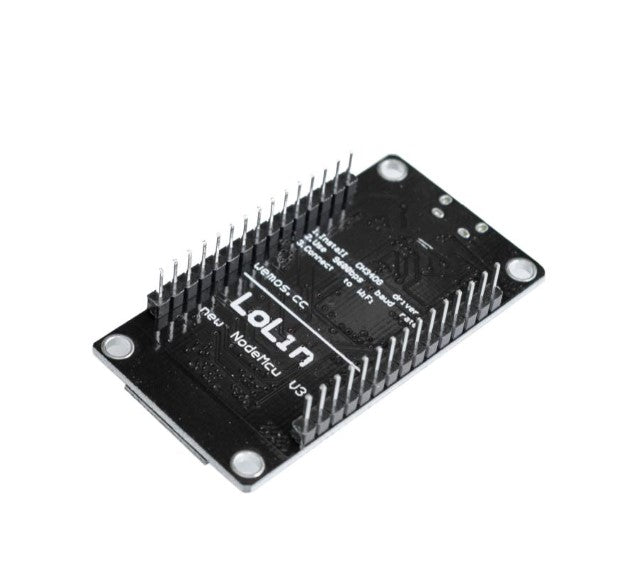NodeMCU V3 ESP8266 12e Development Board CH340
NodeMCU V3 ESP8266 12e Development Board CH340 - If you're tired of always hooking up auxiliary components to debug your ESP8266 Wi-Fi modules, then here's a board just for you!
The NodeMCU V3 is a breadboard-friendly open-source ESP8266 development kit, armed with the CH340G USB-TTL Serial chip. The CH340 line of chips is notoriously known as the affordable alternative to the CP210x. Whilst cheaper, CH340 is super reliable even in industrial applications. It is tested to be stable on all supported platforms as well.
With an integrated USB interface, you can easily use it with the Arduino IDE or NodeMCU Lua.
Needless to say, IoT applications have witnessed a boom in the industry to make connecting objects more important. Today, we have several methods to connect objects, including Wi-Fi protocols and others. When it comes to NodeMCU, is an open-source platform that is based on ESP8266. It offers the provision to connect objects to facilitate the data transfer using Wi-Fi protocols.
Further, the NodeMCU Development Board furnishes many crucial features of microcontrollers i.e. PWM, ADC, and GPIO to handle other specific needs of projects. Some of the highlighting specifications of this development board include;
- Easy to use
- Integrates an internal antenna
- Works as an access point/station
- Programmability with Arduino IDE
- Useful in Event-driven API applications
- Hosts 13 GPIO pins
ESP8266 NodeMCU Development Board – Description
ESP8266 NodeMCU is quite a popular development board that is broadly implemented across the internet world. . It is based on the ESP-12E Wi-Fi module that is perfectly associated with the combination of elements of easy programming with Arduino IDE as well as Wi-Fi capability. It is based on the ESP-12E Wi-Fi module that is perfectly associated with the combination of elements of easy programming with Arduino IDE as well as Wi-Fi capability. The prototyping and development projects can be handled smoothly via the inbuilt programmer and CH340G USB-to-serial chip that flashes the ESP8266 and serial output on PC integration.
The NodeMCU development board integrates ESP8266.It is a well-integrated chip that is specifically crafted to cater to the requirements of a new connected world. Clients enjoy an extensive package of Wi-Fi solutions. The unit allows to either host the application or to offload all Wi-Fi networking functions derived from another application processing unit.
One of the prestigious gems of the NodeMCU board is that it implements the highly popular ESP8266 Wi-Fi Module chip. The chip contains an ESP-12 SMD footprint alongside embedding all necessary components for the ESP8266 to program and upload code. It involves an inbuilt USB to serial chip upload codes to connect multiple circuits. Also, the unit is smart, simple, interactive, and open-source.
People Also Ask:
Q1: How is the ESP8266 12E installed?
Ans: The Complete Guide for ESP8266 NodeMCU V3 IoT Startup is now available.
Installing the board's firmware is the first step in using a NodeMCU board. For all NodeMCU Boards, the method described below works.
- Open the win32/win64 folder on your computer after opening the NodeMCU flasher master folder. now click twice on ESP8266Flasher after opening the folder Release.
- Pick a COM port.
- access the config tab
- After clicking the tiny gear, launch the downloaded firmware.
- choose the desired Baudrate under the Advanced tab.
- Select the Flash Button under the Operation tab.
You are now prepared to use the ESP8266 for programming after installing the firmware.
- Installation of the Arduino IDE
- Click the desktop icon to launch the Arduino IDE.
- Select the File tab, and then select Preferences.
- Add the following URL (http://arduino.esp8266.com/stable/package esp8266com index.json) to the extra Boards Manager URLs and click OK.
- Goto Tools>Borads>Boards Manager
- Type esp8266 into the search box, select esp8266 by ESP8266 Community, and click Install.
You can now use your NodeMCU board as you choose.
Q2: What distinguishes the NodeMCU from the Arduino?
Ans: Both microcontroller boards work well in their intended environments. One can select the best microcontroller board that meets their needs based on the technical criteria. Both boards have benefits and drawbacks that set them apart from one another.
Arduino has advantages over NodeMCU
- Better Processor and Memory: NodeMCu has a 4MB flash memory and an 80MHz clock speed.
- TCP/IP Stack built-in - loT The NodeMCU has a WiFi connection and is prepared to access the internet. It functions best in loT applications.
- Less expensive: The ESP8266 chip-based NodeMCU microcontroller development board is significantly less expensive than the Arduino UNO.
- Compact and suitable for breadboards: A breadboard may be quickly and simply used to test different circuit designs with the NodeMCU. In contrast, the Arduino UNO cannot fit on a breadboard.
Advantages of NodeMCUOverArduino:
- Widespread support: The Arduino UNO has excellent online content available, and the Arduino community is quite active worldwide. More educational content is available than with NodeMCU.
- Easy interaction with sensors and actuators: Compared to NodeMCU, Arduino UNO supports both 3.3V and 5V modules, making it easier to interface with a variety of sensors and actuators.
- The Arduino UNO is capable of handling voltages of up to 20V. However, the NodeMCU can only handle voltages of up to 12V.
- Current per pin: The 40mA current per pin that the Arduino UNO can handle. However, the NodeMCU can only manage 12mA of current.
Major Components:
Further, the ESP8266 NodeMCU development board hosts several crucial elements on a single board just like Arduino boards. You will witness voltage regulators, ADC, GPIO pins, Micro-USB ports, and some other elements. Significantly, the ESP8266 supports full Wi-Fi to accommodate Wi-Fi communication to a client or server. Also, the unit is a system on a chip (SoC) that is manufactured by the Chinese organization Espressif. Significantly, the ESP8266 supports full Wi-Fi to accommodate Wi-Fi communication to a client or server. Also, the unit is a system on a chip (SoC) that is manufactured by the Chinese organization Espressif. The integration involves a Wi-Fi transceiver and Tensilica L106 32-bit microcontroller unit.
In terms of other prominent aspects, the ESP8266 NodeMCU board features 11 GPIO pins along with an analog input. Ultimately, it allows you to program it like any Arduino or other microcontroller. In connectivity, the development board supports you in multiple ways. It brings Wi-Fi communication by allowing you to connect to a Wi-Fi network and host a web server with real webpages. Also, you can connect your smartphone with it. Hence, the chip has gained immense prominence and become the most popular IoT device available in the market. Ultimately, it allows you to program it like any Arduino or other microcontroller. In connectivity, the development board supports you in multiple ways. It brings Wi-Fi communication by allowing you to connect to a Wi-Fi network and host a web server with real web pages. Also, you can connect your smartphone with it. Hence, the chip has gained immense prominence and become the most popular IoT device available in the market.
There is an inbuilt 32-bit low-power ROM, RAM, and CPU. The self-contained Wi-Fi spectrum solutions can carry software applications as a stand-alone device.
Specifications:
Various highlighting specifications and features of the ESP8266 NodeMCU Development Board are as follow:
- Tensilica L106 32-bit micro controller unit at 80 MHz
- 32 KB + 80 KB RAM
- 16 kB ETS system data RAM
- Flash Memory: 4Mb
- USB: micro USB port for power, programming and debugging
- Flash memory attachable: 16MB max (512K normal).
- Maximum concurrent TCP connections: 5.
- GPIO pins: 13
- Wi-Fi: 802.11 b/g/n, supporting WPA/WPA2
- Voltage:3.3V.
- modes support: STA / AP
- Pulse-Width Modulation (PWM)
- Temperature: -40℃ ~ + 125 ℃
- Processor speed: 80~160MHz.
- Humidity: 10%-90% non-condensing
- TCP / IP protocol stack, One socket
- 32-bit hardware timer
- 802.11 support: b/g/n.
- Analog to Digital: 1 input with 1024 step resolution.
- Interrupt capability
- Server and Client: TCP / UDP
- Pin: Compatible with Arduino UNO, Mega
- KEY button: modes configuration
- GPIOs: 17 (multiplexed with other functions).
- Serial Wi-Fi transmission rate: 110-460800bps
- +19.5dBm output power in 802.11b mode
- Wi-Fi Direct (P2P), soft-AP.
- Current consumption: 10uA~170mA.
- Integrated TCP/IP protocol stack.
- Processor: Tensilica L106 32-bit.
- Weight: about 20g (0.7oz)
- Wi-Fi Direct (P2P), soft-AP.
- Serial Wi-Fi transmission rate: 110-460800bps
- Server and Client: TCP / UDP
- Analog to Digital: 1 input with 1024 step resolution.
- Pulse-Width Modulation (PWM)
- Flash memory attachable: 16MB max (512K normal).
Specifications:
- Voltage:3.3V.
- Wi-Fi Direct (P2P), soft-AP.
- Current consumption: 10uA~170mA.
- Flash memory attachable: 16MB max (512K normal).
- Integrated TCP/IP protocol stack.
- Processor: Tensilica L106 32-bit.
- Processor speed: 80~160MHz.
- RAM: 32K + 80K.
- GPIOs: 17 (multiplexed with other functions).
- Analog to Digital: 1 input with 1024 step resolution.
- +19.5dBm output power in 802.11b mode
- 802.11 support: b/g/n.
- Maximum concurrent TCP connections: 5.
Documents:




